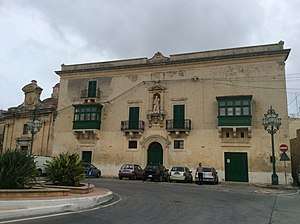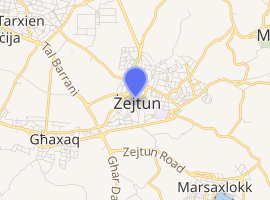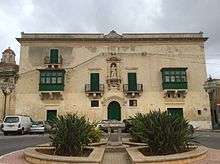Ædes Danielis
Ædes Danielis (transl. House of Daniel; Maltese: Dar ta' Danjeli), sometimes known as Palazzo Gregorio Bonici (transl. Gregorio Bonici Palace; Maltese: Palazz Girgor Bonici), is a late 17th century renaissance building with a private garden in Żejtun, Malta.[3] It is a historic private property built by Gregorio Bonici as his secondary residence, and is now owned by the descendants of the Bonici and Testaferrata families.[4][5][6]
| Ædes Danielis | |
|---|---|
 | |

| |
| Former names | Gregorio Bonici Palace |
| General information | |
| Status | Intact |
| Type | Originally a country house, now a primary residence |
| Architectural style | Renaissance |
| Location | 28, 29 and 30 Misrah Karlu Diacono, two unnumbered doors in Triq il- Madonna tal-Bon Kunsil, three unnumbered doors in Triq Santa Marija, three unnumbered doors in Triq Luqa Briffa, at Żejtun, Malta |
| Coordinates | 35°51′14″N 14°31′52″E |
| Named for | Prophet Daniel Gregorio Bonici |
| Completed | 1659 |
| Owner | Testaferrata Bonici family |
| Technical details | |
| Material | Limestone |
| Floor count | 3 |
History
Ædes Danielis is a 17th-century country-house, built in 1659 as a secondary residence for the nobleman Gregorio Bonici.[7][8] Bonici was one of the donors of the land where the parish church now stands.[9] Bonici was a successful trader in the wheat industry and occupied some of the highest civilian positions in Malta.[10] In fact, he was the castellan (Maltese: Ħakem) of Mdina during the reign of Grandmaster Lascaris.[11][12][13]
Gregorio Bonici had offered the land in front of Aedes Danielis to build a larger parish church for the locality but, owing to criticism for being distant from some villagers, it was then decided to alternatively donate other land.[14][15] The family had no children but, similar to other well-to-do families, owned slaves who took care of the household. Two of the slaves were given their freedom after they convinced their owner of their conversion to Christianity and by marrying them to men he approved.[16][17] His favourite among the former slaves was Angela who was permitted to take Bonici as her surname. She was given freedom and allowed to get married, living a normal life. She and her husband named their son Daniel, who became a priest thanks to a prerequisite sum of money for priesthood donated by Gregorio.[18]
Following the death of Gregorio Bonici, his childless wife inherited his assets, including the building which remained her residence until her death three years later.[19] The building later passed to other members of the Bonici family who intermarried with the Testaferrata family, and eventually with the Moroni Viani family.[20][21]
The garage at the back of the property was used as a massive storage for the decorations of the feast of the village, until around WWII.[22] The building was requisitioned by the British army during WWII to be used by servicemen stationed in the area.[23][24] The garden, forming part of the property, was directly hit by enemy aerial bombing on 11 May 1941, at around 9pm, just before sunset.[25]
The nobility was abolished around 1974.[26]
The building is also known as Palazzo Aedes Danielis and Aedes Danielis Palace,[7] however the words palazzo or palace are redundant as the Latin word ‘aedes’ means house.[27] It is known by some locals as the il-Palazz tal-Markiża (transl. Palace of the Marquess).[28]

Undenied word of mouth has it that Bonici's brother, Daniele Bonici, was buried alive after being sexually abused by priests in Birgu. Daniele was 14 years at the time of his death - he served as an altar boy and following the abuse the priests opted for a way to seal their criminal deeds.[10] The building is claimed to be named after him,[29] but it is more likely to have been named for the niche of Prophet Daniel, which is centrally located on the main façade.[30]
The building and its chapel were robbed extensively in two separate occasions - once in January 1980 and again in August 1981.[31][32] In June 1999, Maria Testaferrat Bonici died and she left in her will all the belonging to her three children a third each, including the building. The heirs mentioned in the will are Agnes Gera de Petri, Annamaria Spiteri Debono, and Caren Preziosi.[33][34] The building was eventually divided into several residences, with different door numbers for the family members.[20]
The building is mentioned as an official address in the Paradise Papers.[35]
Architecture
The building goes back to the renaissance,[36] originally as a country residence, and is today a landmark welcoming visitors on one of the main streets to the city of Żejtun.[37][38] The façade is imposing on its surrounding environment.[39] The building, with its ancillary structures and gardens, is a scheduling property as published on the Government Gazette of Malta of July 2009.[40]
A large religious niche, with an imposing life size statue of biblical Prophet Daniel, is a prominent feature on the façade.[41] The statue is one of only two statues in Malta which are representative of an Old Testament personage.[10] The face of the statue is associated to that of Gregorio Bonici as depicted on a painting located at the Parish Church.[8] The niche is adorned with inscriptions, including dates, and other architectural elements, such as lions’ heads and a coat-of-arms.[42][43] The latter is a listed national monument.[44]
Adjoining the building is a chapel which is dedicated to the Our Lady of Good Counsel. It was built in 1768 to a Baroque design and financed by Enrico Testaferrata.[45][46] This forms part of the private property and is sometimes opened to the public.[47] The chapel is separately listed as a national monument.[48]
See also
References
- Tepfenhart 2014, p. 307
- Borg 2007
- Chircop 2019
- Abela 2011a, p. 71
- Whitake 1922, p. 496
- Whitake 1925, p. 513
- Local Government 2018
- Zammit 2016, pp. 70, 71
- Abela 2008, pp. 41-44
- Grima 2019
- Vassallo 1854, p. 740
- Abela 2009a
- Abela 2011b
- Abela 1992, pp. 54, 55
- Falcon 2011, pp. 1-20
- Abela 2009b, pp. 55-59
- Abela 2013
- Abela 2001, pp. 137-142
- Abela 2012a, pp. 14-16
- McKeon 2017, pp. 1-53
- Debono 2017, pp. 1-3
- Baldacchino 2008, pp. 65-71
- Zahra 2013
- Baldacchino 2009, pp. 1, 2
- Baldacchino 2001, pp. 20-25
- Gauci 2019
- Cascelli 2016
- Farrugia 2007, pp. 42-44
- Carabott 2018
- Abela 2013a
- Scicluna 2001, pp. 1-15
- Aguis 2001, pp. 1-20
- Azzopardi 2019, pp. 1-41
- Marshall 2018, pp. 1330-1359
- ICIJ 2016
- Abela 2019
- Nina & Sandra 2014
- Chircop 2015
- EC 2015, pp. 40, 41
- Government of Malta 2009
- Stranges 2017
- Abela 2012b
- Abela 2013b
- NICPMI 2013a, pp. 1, 2
- Borg 1975, pp. 163-169
- Abela 2013c
- Abela 2011c
- NICPMI 2013b, pp. 1, 2
Bibliography
Books
- Abela, Joe (1992). 300 Sena Ilu: Tifkira tat-tqegħid ta’ l-ewwel ġebla tal-Knisja Parrokkjali taż-Żejtun 1692-1992 (in Maltese). Gutenberg Press Malta.CS1 maint: ref=harv (link)
- EC, (European Commission) (2015). "Zejtun: Local Intangible Heritage". EDEN (Experiencing Emerging European Destinations) Awards: Malta & Gozo (PDF). European Destinations of Excellence: Winners and Runner-Ups. p. 40, 41.CS1 maint: ref=harv (link)
- Vassallo, Giovanni Antonio (1854). Storia di Malta (in Italian). Tip. Francesco Cumbo. p. 740.CS1 maint: ref=harv (link)
Magazines
- Whitake, J. (1922). "Whitaker's Peerage, Baronetage, Knightage and Companionage for the Year 1922". J. Whitaker & Sons. p. 496. OCLC 3578259.CS1 maint: ref=harv (link)
- Whitake, J. (1925). "Whitaker's Peerage, Baronetage, Knightage, and Companionage for the 1925". J. Whitaker & Sons. p. 513. OCLC 5533373.CS1 maint: ref=harv (link)
Journals
- Abela, Joe (2001). "Dun Danjeli Żammit (1688-1731): Rettur tal-Knisja ta' San Ġorġ". Leħen il-Banda (in Maltese). Għaqda San Pietru Fil-Ktajjen A.D. 1957.CS1 maint: ref=harv (link)
- Abela, Joe (2008). "Ulied il-Qalb ta' Gesù fiz-Zejtun (1908 - 2008)". Festa Zejtun 2008 (in Maltese): 41-44.CS1 maint: ref=harv (link)
- Abela, Joe (12 October 2009a). "Girgor Bonici". ‘Leħen il-Banda’ tal-Għaqda Mużikali San Pietru Fil-Ktajjen A.D. 1957 (in Maltese).CS1 maint: ref=harv (link)
- Abela, Joe (2009b). "Ilsiera ma' familji Zwieten fl-imghoddi" (PDF) (in Maltese) (28). Ghaqda Muzikali Beland: 55–59. Cite journal requires
|journal=(help)CS1 maint: ref=harv (link) - Abela, Joe (26 May 2011b). Keith Vella (ed.). "Girgor Bonici". Art by Zejtun PPL.CS1 maint: ref=harv (link)
- Abela, Joe (June 2011a). "Dun Karm Vella (1855 - 1910)" (PDF). Festa Santa Katerina V.M. (in Maltese): 71. Archived from the original (PDF) on 8 July 2019.CS1 maint: ref=harv (link)
- Abela, Joe (2012a). "400 Sena mit-twelid ta' Girgor Bonici" (PDF). Festa Zejtun 2012: S. Katerina V.M. (in Maltese): 14–16.CS1 maint: ref=harv (link)
- Baldacchino, Carmelo P. (June 2001). "Vittmi Zwieten matul il-Gwerra li ghaddiet" (PDF). Festa Santa Katerina V.M. (in Maltese). Ghaqda Banda Zejtun.CS1 maint: ref=harv (link)
- Baldacchino, Carmelo P. (June 2008). "L-Armar tal-Festa fl-imghoddi" (PDF). Festa Santa Katerina V.M. (in Maltese): 65–71.CS1 maint: ref=harv (link)
- Baldacchino, Joe (June 2009). "It-Tracedja tal-Pjazza taz-Zejtun" (PDF) (in Maltese). Ghaqda Banda Zejtun A.D. 1933: 1, 2. Cite journal requires
|journal=(help)CS1 maint: ref=harv (link) - Borg, Vincent (1975). "Our Lady of Good Counsel". Melita Historica. Malta Historical Society: 163–169.CS1 maint: ref=harv (link)
- Government of Malta (July 2009). "Legal Notices" (PDF). Government Gazette. Archived (PDF) from the original on 15 July 2019. Retrieved 15 July 2019.
...... as Aedes Danielis, Żejtun, including the gardens and the. Chapel tal-Bon Kunsil and ...
CS1 maint: ref=harv (link) - Zammit, Massabielle (2016). Christopher Chetcuti (ed.). "Nicec fit-Toroq Taghna". Festa Sta. Katerina V.M. (in Maltese) (32 ed.). Ghaqda Banda Zejtun: 70, 71.CS1 maint: ref=harv (link)
- Farrugia, Connie (2007). "Rahal Twelidi" (PDF). Santa Katerina V.M. (in Maltese). Festa Zejtun 2007: 42–44.CS1 maint: ref=harv (link)
News
- Carabott, Sarah (10 August 2018). "Żejtun treasure hunt being held on Friday: Third edition is great way to find out about town's history". Times of Malta. Archived from the original on 9 July 2019.CS1 maint: ref=harv (link)
- Gauci, Charles (11 February 2019). "Malta's aristocracy: The peerage in Malta consists of the Maltese nobility together with the holders of bona fide foreign titles". Times of Malta. Retrieved 10 July 2019.CS1 maint: ref=harv (link)
- Grima, Noel (5 May 2019). "Murder most foul – hypothesis over boy's rape hundreds of years ago". The Malta Independent. Archived from the original on 9 July 2019.CS1 maint: ref=harv (link)
- ICIJ (2016). "Aedes Danielis, Triq il-Madonna ta' l-Bon Kunsill, Zejtun". Offshore Leaks Database.CS1 maint: ref=harv (link)
Court cases
- Aguis, Carmel A. (Judge) (30 October 2001). "Il-Pulizija (Sup. Daniel Gatt) vs Francis Vella". Criminal Court of Appeal (in Maltese). Numru 5 (Appell Nru. 264/92): 1–20. Archived from the original on 9 July 2019.CS1 maint: ref=harv (link)
- Azzopardi, Joseph (Judge) (12 April 2019). "Caren mart Dr Josef Preziosi, Annamaria mart John Spiteri Debono vs Agnes Gera de Petri Testaferrata Bonici Ghaxaq". Civil Court of First Instance (in Maltese). Kawza Nru: 26 (Nru: 591/13 JA): 1–41.CS1 maint: ref=harv (link)
- Marshall, of the Court (28 August 2018). "Court Notices". Malta Government Gazette (20, 046): 1330–1359.CS1 maint: ref=harv (link)
- McKeon, Joseph Zammit (Judge) (31 January 2017). "Agnes Gera de Petri Testaferrata Bonici Ghaxaq (nru tal-Identita` 454749 M) kontra Annamaria Spiteri Debono (ID 380861M) sew personali kif ukoll fil-kwalita` taghha ta` prokuratrici ta` Caren Preziosi (ID340952M) u f`din l-ahhar kwalita` ghall-interess li jista` jkollha l- imsemmija Caren Preziosi". Civil Court of First Instance (in Maltese). Kawza Nru. 3 (Rik. Gur. Nru. 797/08 JZM): 1–53. Archived from the original on 8 July 2019.CS1 maint: ref=harv (link)
- Scicluna, David (Judge) (22 June 2001). "Baronessa Maria Testaferrata Bonici, armla, Beatrici Testaferrata Moroni Viani, xebba, il-Markiza Agnese Gera De Petri Testaferrata Bonici Ghaxaq mart Alfred Gera De Petri u l-istess Alfred Gera De Petri bhala amministratur tal- beni parafernali tal-istess martu, Anna Maria Spiteri Debono sew proprio kif ukoll bhala prokuratrici tal-Kontessina Karen Preziosi u John Spiteri Debono bhala amministratur tal-beni parafernali ta' martu vs Francis Vella". Court of First Instance (in Maltese). Numru 44 (Citaz. numru 991/92 DS): 1–15. Archived from the original on 9 July 2019.CS1 maint: ref=harv (link)
Tribunal cases
- Debono, Annamaria Spiteri (8 March 2017). "PA/02603/15". Environment and Planning Review Tribunal. pp. 1–3. Archived from the original on 8 July 2019.CS1 maint: ref=harv (link)
Online
- Abela, Joe (2013). "Development of Zejtun Hamlets". Zejtun: Religious Heritage Trail.CS1 maint: ref=harv (link)
- Abela, Ruben (2013b). "Niċeċ u Statwi: Danjeli fuq id-Dar ta' Danjeli". Wirt iż-Żejtun: Napprezzaw, Nipproteġu u Nippromwovu il-Wirt Kulturali Tagħna (in Maltese).CS1 maint: ref=harv (link)
- Abela, Ruben (13 May 2012b). "Street Shrines: The Statue of Daniel on Daniel's House". Wirt iż-Żejtun: Appreciation, Protection & Promotion of Our Local Cultural Heritage.CS1 maint: ref=harv (link)
- Abela, Ruben (4 April 2011c). "Il-Kappelli: Il-Kappella tal-Madonna tal-Bon Kunsill". Wirt iż-Żejtun: Appreciation, Protection & Promotion of Our Local Cultural Heritage (in Maltese).CS1 maint: ref=harv (link)
- Abela, Ruben (2019). "Aedis Danielis". PlakkaStorja. Archived from the original on 8 July 2019.CS1 maint: ref=harv (link)
- Abela, Ruben (30 October 2013a). "Beltna: Il-Palazz Aedis Danielis". Napprezzaw, Nipproteġu u Nippromwovu il-Wirt Kulturali Tagħna (in Maltese). Archived from the original on 8 July 2019.CS1 maint: ref=harv (link)
- Cascelli, Flora (24 September 2016). "Experience Zejtun during the Olive Oil Festival". Exploring Malta: Experiencing the South Villages. Archived from the original on 8 July 2019.CS1 maint: ref=harv (link)
- Chircop, Glenn (2015). "Il-Palazz Aedes Danielis". Il-Kunsill Lokali taż-Żejtun (in Maltese).CS1 maint: ref=harv (link)
- Chircop, Glenn (2019). "Żejtun Local Council: Aedes Danielis Palace". Żejtun Local Council. Archived from the original on 7 July 2019.CS1 maint: ref=harv (link)
- Local Government (2018). "Places of Interest". Government of Malta. Archived from the original on 9 July 2019.CS1 maint: ref=harv (link)
- Stranges, Paola (27 December 2017). "Zejtun la città maltese che coltiva olio". Italiani a Malta (in Italian).CS1 maint: ref=harv (link)
- Zahra, Frans (2 December 2013). "Feasts and Traditions". Zejtun: Religious Heritage Trail.CS1 maint: ref=harv (link)
Reports
- Falcon, Maltese (February 2011). St. Catherine Parish Church, Zejtun: Restoration Method Statement (PDF). Maltese Falcon (Report). pp. 1–20.CS1 maint: ref=harv (link)
- NICPMI (27 December 2013a). "Niche of Prophet Daniel" (PDF). National Inventory of the Cultural Property of the Maltese Islands (1912): 1, 2.CS1 maint: ref=harv (link)
- NICPMI (27 December 2013b). "Chapel of Mater Boni Consilii" (PDF). National Inventory of the Cultural Property of the Maltese Islands (1914): 1, 2.CS1 maint: ref=harv (link)
Other
- Abela, José (9 April 2013c). "¡Malta, por fin…!". joseabelam (in Spanish).CS1 maint: ref=harv (link)
- Borg, Victor Paul (21 September 2007). "The facade of Aedes Daniels Palace in Zejtun, Malta". Alamy (ID: B6HCN0). Archived from the original on 8 July 2019.CS1 maint: ref=harv (link)
- Nina; Sandra (2014). "Towns & Villages: Zejtun". Maltassist.CS1 maint: ref=harv (link)
- Tepfenhart, Rudolf (11 November 2014). "Gregorio Bonnici's palace, Malta". Rudolf-Tepfenhart. p. 307. Archived from the original on 8 July 2019.CS1 maint: ref=harv (link)
External links
- Aedis Danielis - PlakkaStorja
- Aedis Danielis Palace Jigsaw Puzzle
| Wikimedia Commons has media related to Aedes Danielis Palace. |